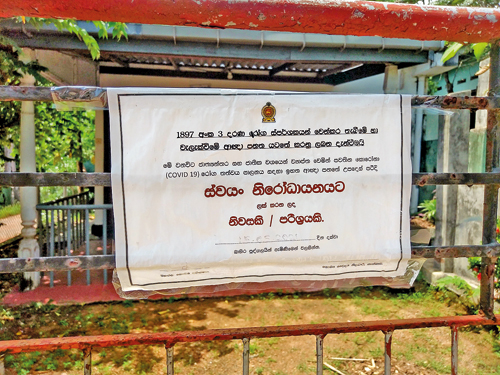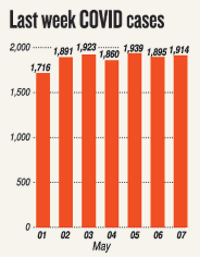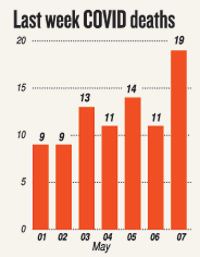News
Lockdown to curb rapid virus spread – experts
View(s):
A house in Kesbewa with a quarantine notice
A “lockdown” is the “only” answer to stem the COVID-19 tsunami engulfing the whole of Sri Lanka, otherwise the country is on the verge of tipping over and crashing into an abyss of a high number of deaths, warned experts from across the health spectrum.
“We will go down the slippery slope like India. We are already tumbling down, but action right now would help mitigate the looming COVID-19 disaster,” a respected expert said, declining to be named.
This expert, with numerous others agreeing, said that what they are recommending is based purely on science and the bitter experiences of other countries.
“Already, the hospitals are bursting at their seams and overwhelmed. Public health officials working at ground level and staff managing the hospitals are exhausted and at breaking point. There is serious doubt whether the country’s oxygen capacity is adequate to meet future requirements (as India has found to its cost). The laboratories cannot cope with the massive inflow of tests,” the expert said.
 As the Sunday Times received numerous calls about the stranglehold of COVID-19 on the country, these experts pointed out that they are not “crying wolf” for the sake of doing it, but taking into account the reality at ground-level.
As the Sunday Times received numerous calls about the stranglehold of COVID-19 on the country, these experts pointed out that they are not “crying wolf” for the sake of doing it, but taking into account the reality at ground-level.
Urging that the decision-makers look at the numbers being put out by the Health Ministry [on May 7 (Friday), there were 1,914 identified infections and 19 deaths], they said about two or three weeks ago, we might have got away with “a slew of restrictions short of a full ‘lockdown’, but that opportunity is now passed. Now a lockdown is the only action possible”.
 They pointed out that the RT-PCR “S-drop signal” detected and reported in early April was very concerning, was evidence of a variant, most likely the UK variant, which was rapidly increasing in numbers. We did not need to wait for virus genome sequencing to take initial precautionary action. Now there is no more time to be lost.
They pointed out that the RT-PCR “S-drop signal” detected and reported in early April was very concerning, was evidence of a variant, most likely the UK variant, which was rapidly increasing in numbers. We did not need to wait for virus genome sequencing to take initial precautionary action. Now there is no more time to be lost.
“At the rate that we are going, there’s such a backlog in RT-PCRs, we are kind of looking at the situation of many days ago, not the current situation. So you know, basically the whole system is getting overwhelmed. Everything from diagnostics, from contact tracing, from patient isolation, from patient management and before you know it, we will be like India,” an expert said.
“The virus has changed also in severity because it is affecting younger people and it is affecting many more people.
“Now we are dealing with a different animal again. The only option at this late stage is a lockdown, at least to serve as a ‘circuit breaker’ to blunt the rapid increase of cases we are seeing now. The longer we delay, the greater will be the cost, both to human life and the economy,” he said.
| The dangers of India’s double-mutant virus | |
| “The Indian virus variant (B.1.671) is called ‘a variant of interest’ by the World Health Organization (WHO). It hasn’t been called ‘a variant of concern’ yet. The reason why it is not yet designated a ‘variant of concern’ by the WHO is not because it is not of concern but because there is no data from India on which to make the assessment. India hasn’t done the science necessary to find out,” said a senior virologist.Currently, the three ‘variants of concern’ are the UK one, the South African one and the Brazilian one. This poses two major issues – Is the Indian variant more transmissible than the original wild virus? This has to be determined by epidemiological studies, which either have not been done or we have not seen, the virologist said. Is the Indian variant able to escape the antibody immunity from natural infection or from vaccination? The virologist explained that there is a preprint from Indian authors from Bharat (the vaccine company) which basically seems to suggest that there is not much of a difference, implying that the Indian variant does not escape vaccine immunity. This expert said: “This is difficult to believe. Scientists who have been studying the variants have found that there is a dangerous mutation at position 484 of the spike gene, very similar though not identical, to the one found in the South African and Brazilian viruses which can partially evade immunity from past infection and vaccines. Whereas the South African and Brazilian variants have what is called the 484K, the Indian virus is 484Q, but it has a mutation compared to old virus. Then, when you look at the facts on the ground, serological studies carried out on blood samples from Maharashtra including Mumbai at the end of last year, showed that roughly about 50% of the population already had antibodies, meaning that they had already been infected in the first wave. “Now, you have this blast through with this second wave, in Maharashtra, primarily with the new Indian ‘double mutant’. It has to mean that previous immunity is not holding the virus back. There is a high possibility that the double mutant will also evade immunity from vaccine. If that is the case and we allow this virus also to take hold in Sri Lanka, even the vaccine when it comes in future may not save us,” said a source. |


